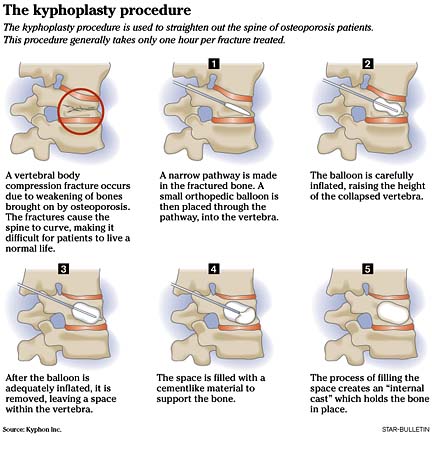


|
New spinal procedure successful SEVERE back pain made it increasingly difficult for Patsy Choy to do her job making poke at Tamashiro Market.
Called kyphoplasty, the surgery
involves an injection of cement
into injured vertebraeBy Helen Altonn
haltonn@starbulletin.com"Right through, it was terrible, and I cannot walk one block to home from the bus," she said. "I had to stop three times because it hurt."
Bending forward, she described how her body leaned that way, "even when washing dishes."
Choy, who is 77, did not know she had osteoporosis (weakened bones from loss of calcium) until she went to Dr. Morris Mitsunaga on July 10, after falling and fracturing a vertebra two weeks earlier.
Mitsunaga, an orthopedic surgeon, told Choy about kyphoplasty, a new treatment he has introduced to the island for patients with osteoporosis and compression fractures.

A compression fracture occurs when a vertebra in the spine collapses, causing severe pain and a deformity known as "kyphosis" or "dowager's hump."Kyphoplasty involves making a quarter-inch incision in the back and using a catheter, guided with fluoroscopy, to create a path into the fractured area, Mitsunaga explained.
A special balloon is inserted into the fractured bone and carefully inflated to raise the collapsed vertebra and restore its height to try to straighten the spine, he said. The balloon is removed, leaving a space that is filled with cementlike material to hold the bone in place.
It is the same type of cement used for 20 years in knee and hip replacements to fix a prosthesis to the bone, Mitsunaga said.
But Choy was wary. "When he first told me about it, I thought, 'Oh, not cement in my body.'"
Despite the pain, she put off surgery and went to Oregon in October to visit a daughter.
"After that, every day I had to put on a corset to go to work. I said, 'I hate to have a corset every day.' The pressure ... it hurts. I say, 'Oh, I think I'm going to do this.'"
She became Mitsunaga's first Oahu patient to undergo the one-hour procedure on Nov. 12 at the Queen's Medical Center. She was discharged the next day.
"Right after surgery, my body felt light," she said. "I straightened up. No pain, no nothing. It was real good."
Choy returned to work in December. "I'm on my feet all day," she said in a recent interview. "Now it doesn't bother me. I used to have pain. Now I work seven, eight hours a day."
Her four daughters and fellow workers "say it's real good because I'm not complaining," she added. "Even at work, (it was) 'My back, my back.'"
"It's amazing," Mitsunaga said, explaining Choy "was significantly disabled" when he first saw her.
He said her case is typical of those orthopedic physicians are seeing as the population ages. "It's more common in women as they get menopause and have changes in life."
A lot of new drugs are coming out to prevent bone loss and test for osteoporosis to identify patients with high risk, he said.
"Theoretically, we should see less, but the population is getting older, and the numbers haven't really come down. We see a lot of osteoporosis. It's a big public-health issue."
About one-third of patients become seriously debilitated with the disease as they age, Mitsunaga said. "My grandmother lived to 90, had severe osteoporosis and got a round back."
Older patients are stricken with increased pain and depression and are often bedridden, he said, adding that he sees one or two patients daily in that situation.
Before kyphoplasty, treatments were limited to bed rest, pain-relieving drugs and corsets or back braces, he said.
An older surgical procedure called vertebroplasty has been used to treat osteoporotic fractures, Mitsunaga said. It involves injecting cement directly into the fractured bone. This stabilizes a fracture and relieves pain, but it does not correct the compression, he said.
It is a little more complicated and not as successful as kyphoplasty, which eliminates or reduces pain and helps to straighten the spine, he said.
"That is where this thing has been kind of miraculous," he said, pointing out active people like Choy are able to return to work after kyphoplasty.
The Food and Drug Administration cleared the technique after two years of clinical experience, and surgeons across the nation are getting training to use it, said Mitsunaga, who was trained at Stanford. "I'm totally amazed at how this has exploded."
However, many primary-care doctors are not yet aware of the new procedure, and patients are coming to him for the surgery largely by "word of mouth," he said.
Not all patients are candidates for kyphoplasty, and there are some risks with any surgery, but there are few complications, Mitsunaga said.
"I think we're going to see, over the next year or so, a lot more patients being aware of it and a lot more people getting it."
Patients with osteoporosis still need treatment and must be monitored for other compression fractures, Mitsunaga cautioned, citing a 20 percent risk of another vertebra fracture within five years.
He took care of his grandmother, who was in a wheelchair, when he was young, he said.
"I think back on that with every patient I see. I don't want to see that happen. ... At that time we couldn't do anything, just narcotics. She was doped up. It's terrible. I see patients like that every week."
The future may bring noninvasive or minimally invasive bone substitutes, such as calcium phosphate or calcium sulfate, Mitsunaga said.
"But that's way ahead, five to 10 years."
He advises patients with osteoporosis to follow a good diet and exercise. "The more active you are, you stimulate bones; the less active, you lose calcium." Women also should take 1,500 milligrams of calcium daily, he said. "Those simple things can really prevent depression factors."